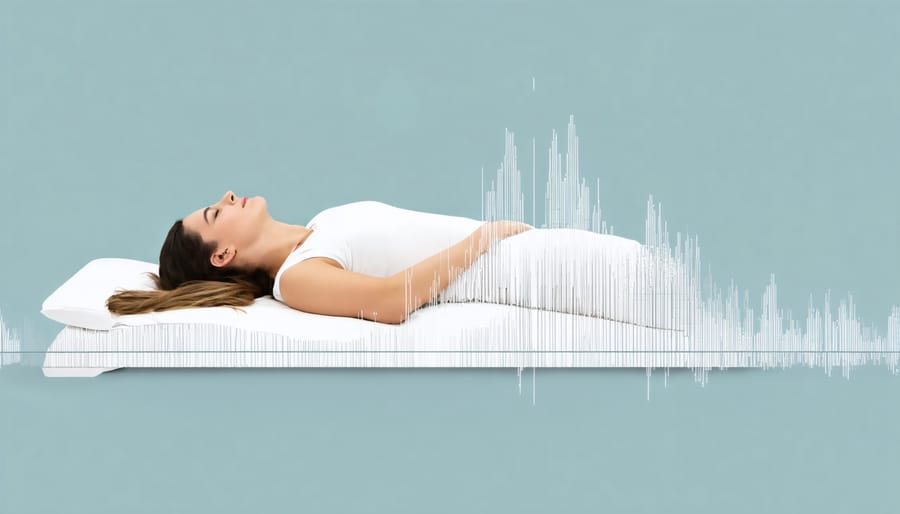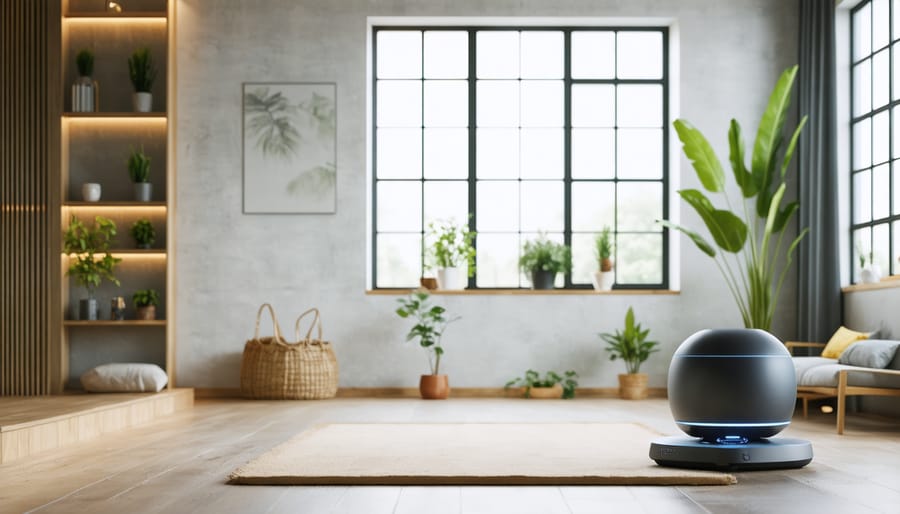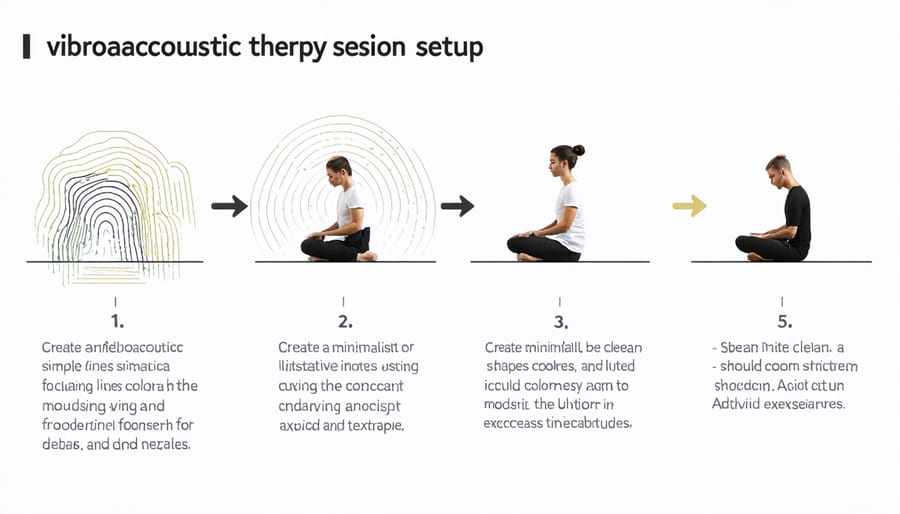Transform your living space into a therapeutic sanctuary with vibroacoustic therapy – a powerful wellness practice that combines low-frequency sound waves with physical vibrations. Using specialized equipment like vibrating mats, chairs, or platforms paired with specific sound frequencies, you can experience deep relaxation, pain relief, and improved well-being without leaving your home.
The beauty of home-based vibroacoustic therapy lies in its accessibility and convenience. Whether you’re dealing with chronic pain, stress, or simply seeking a new approach to relaxation, this science-backed therapy can be seamlessly integrated into your daily routine. Modern vibroacoustic devices are compact, user-friendly, and designed to complement your existing home décor while delivering professional-grade therapeutic benefits.
Setting up your personal vibroacoustic space requires minimal effort but offers maximum impact. From portable vibrating cushions that can be used on any chair to full-body therapy mats that roll away for storage, today’s home solutions make it easier than ever to harness the healing power of sound and vibration. As we explore the essential equipment, setup guidelines, and best practices, you’ll discover how to create your own wellness haven that rivals professional therapy settings.
Understanding Vibroacoustic Therapy
The Science Behind Sound Healing
Sound healing isn’t just a trendy wellness practice – it’s rooted in solid scientific principles. Our bodies are essentially made up of vibrating molecules, and these vibrations can be influenced by external sound frequencies. When specific sound waves interact with our bodies, they can affect our cellular activity, heart rate, and even brainwave patterns.
Think of it like ripples in a pond: when you introduce a vibration, it creates waves that spread throughout your body. These waves can help synchronize your biological rhythms, similar to how calming soundscapes help you relax after a long day.
Research shows that certain frequencies can stimulate the production of feel-good hormones like endorphins while reducing stress hormones like cortisol. The vibrations can also improve circulation and help relax tense muscles by creating tiny, therapeutic movements in your body’s tissues.
What makes vibroacoustic therapy particularly effective is its ability to reach deep into the body. Unlike traditional sound therapy, which travels through the air, vibroacoustic waves penetrate directly through your body’s tissues, creating a more profound physical and mental response.

Benefits for Mind and Body
Vibroacoustic therapy offers a remarkable blend of physical and mental wellness benefits right in the comfort of your home. The gentle vibrations and sound frequencies work together to help reduce muscle tension and alleviate chronic pain, particularly in the back and joints. Many users report experiencing deeper relaxation and improved sleep quality after regular sessions.
The therapy’s impact on mental well-being is equally impressive. The combination of sound and vibration helps calm racing thoughts and reduce anxiety levels, creating a meditative state that’s perfect for stress relief. Regular sessions can boost mood and increase mental clarity, making it easier to tackle daily challenges with renewed energy.
Physical benefits often include improved circulation, reduced inflammation, and enhanced flexibility. The vibrations can help release tight muscles and promote better body awareness. Meanwhile, the therapeutic sounds contribute to decreased blood pressure and regulated breathing patterns.
For those dealing with chronic conditions, vibroacoustic therapy can complement existing treatment plans by providing natural pain management and relaxation techniques. It’s a holistic approach that nurtures both body and mind, promoting overall wellness without medication.
Setting Up Your Home Vibroacoustic Space
Essential Equipment
Setting up vibroacoustic therapy at home requires a few key components to create an effective and comfortable experience. The foundation of your setup starts with a specialized vibroacoustic mat or chair, which contains built-in transducers that convert sound into gentle vibrations. These mats typically range from full-body length to smaller versions for specific areas.
You’ll need a quality sound system or amplifier to deliver the therapeutic frequencies. Look for one with adjustable bass controls and multiple input options. A dedicated sound source, such as a smartphone, tablet, or laptop, will be necessary to play the vibroacoustic frequencies. Many practitioners recommend using a separate device exclusively for therapy sessions to avoid interruptions.
Essential accessories include comfortable bedding or padding to place over the mat, and a set of high-quality audio cables to connect your components. Consider investing in a timer to track session duration and a backup power bank for portable use.
For optimal results, choose products certified for therapeutic use rather than standard audio equipment. While premium vibroacoustic mats can be expensive, starting with a smaller, targeted mat is a practical way to begin. Remember to check product warranties and user reviews, focusing on items designed specifically for home therapy use rather than general audio equipment repurposed for this application.
Store your equipment in a dry, temperature-controlled space to maintain its longevity and effectiveness. Regular maintenance checks will ensure your setup continues to provide consistent therapeutic benefits.
Room Selection and Setup
Creating an effective space for vibroacoustic therapy starts with choosing the right room in your home. The ideal location should be quiet, comfortable, and easily transformed into a personal wellness sanctuary. A spare bedroom, home office, or basement area works well, provided it offers enough privacy and space for your setup.
First, measure your chosen room to ensure it can accommodate your vibroacoustic chair or bed and any additional equipment. You’ll need approximately 50 square feet of uncluttered space for comfortable movement and equipment placement.
Consider these essential setup elements:
– Install light-blocking curtains or blinds to control ambient light
– Remove sources of electronic interference (Wi-Fi routers, phones)
– Add soft floor coverings to minimize sound reflection
– Ensure proper ventilation and temperature control
– Position power outlets within easy reach
Paint the walls in calming colors like soft blues, gentle greens, or warm neutrals. These hues help create a peaceful atmosphere conducive to therapy sessions. Keep decor minimal and purposeful – a few plants, simple artwork, or calming nature photographs can enhance the space without overwhelming it.
Finally, organize your equipment storage thoughtfully. Dedicate a specific area for components and ensure all cables are neatly managed and secured to prevent tripping hazards.

Acoustic Treatment Considerations
Creating the perfect acoustic environment for your vibroacoustic therapy sessions doesn’t have to be complicated. Start by choosing a quiet room away from household traffic and external noise. Consider implementing smart acoustic solutions like heavy curtains or blackout drapes, which not only block light but also help absorb sound.
Pay attention to your room’s surfaces. Hard, flat surfaces can create unwanted sound reflections that might interfere with your therapy experience. Adding soft furnishings like plush rugs, cushions, and upholstered furniture can naturally dampen these reflections. Strategic placement of bookshelves along walls can also help diffuse sound.
For more targeted improvements, explore DIY acoustic treatment solutions such as foam panels or fabric-wrapped acoustic boards. These can be mounted on walls where sound reflection is most problematic. Don’t forget about air gaps – seal any obvious drafts around windows and doors, as these can let in unwanted noise.
Remember to test your room’s acoustics by playing different frequencies through your vibroacoustic system. Listen for any areas where the sound seems uneven or distorted, and adjust your treatment accordingly. The goal is to create a balanced, immersive sound environment that enhances your therapy experience.
DIY Vibroacoustic Therapy Sessions

Getting Started Guide
Before diving into vibroacoustic therapy at home, it’s essential to establish a safe and effective routine. Start by selecting a quiet, comfortable space where you won’t be disturbed during your sessions. The ideal room temperature should be between 68-72°F (20-22°C) for optimal relaxation.
Begin with short 15-20 minute sessions, gradually increasing to 30-45 minutes as you become more comfortable with the therapy. Always start with lower frequencies and vibration intensities, working your way up slowly. Most beginners find frequencies between 40-60 Hz most comfortable to start with.
When setting up your equipment, ensure all connections are secure and power cords aren’t strained or tangled. Place your vibroacoustic mat or chair on a flat, stable surface, away from water sources. If using a mat, consider placing it on a yoga mat for additional comfort and stability.
Essential safety considerations:
– Consult your healthcare provider before starting, especially if you have heart conditions, are pregnant, or have medical implants
– Never fall asleep during a session
– Stay hydrated before and after therapy
– Stop immediately if you experience any discomfort
– Keep electronic components away from water
– Regular equipment maintenance is crucial
For optimal results, maintain a consistent schedule, preferably at the same time each day. Many users find morning or evening sessions most beneficial. Start with simple relaxation programs before exploring more specific therapeutic frequencies.
Remember to keep a journal of your sessions, noting the frequencies used, duration, and how you feel afterward. This helps track your progress and identify the most effective settings for your needs.
Session Timing and Frequency
Getting the most out of your vibroacoustic therapy sessions at home depends largely on establishing a consistent and appropriate schedule. For beginners, start with 15-20 minute sessions, two to three times per week. This allows your body to adjust to the therapy while maintaining a comfortable routine that fits into your daily life.
As you become more familiar with the practice, you can gradually increase session duration to 30-45 minutes, depending on your comfort level and specific wellness goals. Many practitioners find that morning sessions help energize them for the day ahead, while evening sessions can promote better sleep and relaxation.
Listen to your body’s response and adjust accordingly. If you’re using vibroacoustic therapy for stress relief, you might benefit from shorter, more frequent sessions of 10-15 minutes daily. For chronic pain management or deep relaxation, longer sessions of up to 45 minutes, three times weekly, might be more beneficial.
Important timing tips to keep in mind:
– Allow at least 2 hours between sessions
– Avoid sessions immediately after heavy meals
– Schedule sessions when you won’t be interrupted
– Maintain consistent timing for optimal results
– Take a day’s break between longer sessions
Remember that consistency is more important than duration. It’s better to have regular shorter sessions than sporadic longer ones. Start with a schedule you can realistically maintain, and adjust as needed based on your lifestyle and wellness goals. Keep a simple journal to track your sessions and note any changes in how you feel, which will help you optimize your therapy timing over time.
Maintenance and Troubleshooting
Keeping your vibroacoustic therapy equipment in top condition ensures a consistent and effective home wellness experience. Here are essential maintenance tips and solutions for common issues you might encounter.
Regular cleaning is crucial for both comfort and equipment longevity. Wipe down your therapy mat or chair with a slightly damp cloth after each use, paying special attention to areas that come in direct contact with skin. For deeper cleaning, use a mild soap solution monthly, but avoid harsh chemicals that could damage the material.
Check all cable connections before each session to prevent audio interruptions. If you notice any fraying or wear on cables, replace them immediately to maintain safety and optimal sound quality. Keep cables neatly organized and away from high-traffic areas to prevent tripping hazards and unnecessary wear.
Common Issues and Solutions:
– No vibration: Check power connections and volume settings. Sometimes, the issue is as simple as a loose cable or muted audio source.
– Uneven vibration: Ensure your mat or chair is on a flat surface and that internal transducers haven’t shifted. Gentle repositioning usually resolves this issue.
– Static or distorted sound: Clean audio connections with compressed air and ensure all cables are properly seated.
– Weak vibrations: Check your amplifier settings and battery levels if using wireless components.
Store your equipment in a cool, dry place when not in use. Avoid folding therapy mats, as this can damage internal components. Instead, roll them gently or store them flat. For chairs, use a dust cover to protect the surface and components.
Schedule a monthly maintenance check to inspect all components, tighten any loose parts, and test all functions. This proactive approach helps identify potential issues before they become problems that could interrupt your therapy sessions.
If you encounter persistent issues, consult your equipment’s manual or reach out to the manufacturer’s support team for specialized guidance. Most problems can be resolved with simple troubleshooting, but don’t hesitate to seek professional help for complex issues.
Embarking on your vibroacoustic therapy journey at home can be a transformative experience for both your wellness routine and living space. By following the setup guidelines, choosing the right equipment, and creating a dedicated therapy area, you’re well on your way to experiencing the benefits of this innovative therapy in your own sanctuary. Remember to start slowly, listen to your body, and gradually increase session duration as you become more comfortable. Whether you’re seeking stress relief, better sleep, or overall wellness improvement, vibroacoustic therapy offers a unique approach to self-care that fits seamlessly into your home environment. Take that first step today – your body and mind will thank you for introducing this gentle yet powerful therapeutic practice into your daily routine.
